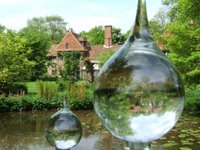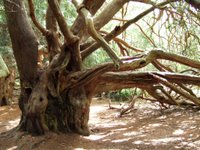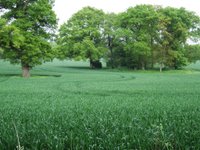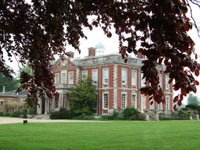 Some English country houses look so fascinating and inviting, you feel you would love to live in one & never leave. We walked around a beautiful country garden on Saturday, surrounding a house of this type.
Some English country houses look so fascinating and inviting, you feel you would love to live in one & never leave. We walked around a beautiful country garden on Saturday, surrounding a house of this type.  The property is called Vann and is open to the public for a very select number of days each year. Photos really don't do it justice.
The property is called Vann and is open to the public for a very select number of days each year. Photos really don't do it justice. Our next walk was rather more strenuous. We looked around the Kingley Vale Nature Reserve, supposedly the largest yew forest in Europe, with trees up to 2000 years old. At that age yew trees have reached a stage where they have grown past being ungainly, and are handsome again. The branches sag to the ground, root at that point and put up leaders that repeat the cycle. One tree had two concentric rings of off-shoots, still connected back to the original trunk. The walk climbed a steep hill, with brilliant views, and took us on to the small village of Stoughton complete with the necessary excellent pub lunch.
Our next walk was rather more strenuous. We looked around the Kingley Vale Nature Reserve, supposedly the largest yew forest in Europe, with trees up to 2000 years old. At that age yew trees have reached a stage where they have grown past being ungainly, and are handsome again. The branches sag to the ground, root at that point and put up leaders that repeat the cycle. One tree had two concentric rings of off-shoots, still connected back to the original trunk. The walk climbed a steep hill, with brilliant views, and took us on to the small village of Stoughton complete with the necessary excellent pub lunch. 
Driving through the beech woods is such a pleasure with the brilliant blue haze of bluebells, seemingly floating ethereally above the green forest floor. Somehow, the pavements of Chichester, where we finished the day, just did not compare.
 Sunday was overcast, hazy, cool, but fine. A harbour walk around Pagham Harbour was a peaceful start to the day, followed by two interesting country houses, both of which had been totally destroyed by fire. The first, Uppark, was destroyed by fire in 1989, and reopened 7 years later. They restored it to the same 'faded glory' it had before, so a visitor returning afterwards, would see it looking the same. Their display of techniques employed was very interesting. What they managed to salvage from a totally gutted shell is simply amazing.
Sunday was overcast, hazy, cool, but fine. A harbour walk around Pagham Harbour was a peaceful start to the day, followed by two interesting country houses, both of which had been totally destroyed by fire. The first, Uppark, was destroyed by fire in 1989, and reopened 7 years later. They restored it to the same 'faded glory' it had before, so a visitor returning afterwards, would see it looking the same. Their display of techniques employed was very interesting. What they managed to salvage from a totally gutted shell is simply amazing. The second house: Stanstead Park, was burnt down in 1903, and rebuilt in a grander style. After 100 years of wear and tear, this house also has a type of 'faded glory'.
The second house: Stanstead Park, was burnt down in 1903, and rebuilt in a grander style. After 100 years of wear and tear, this house also has a type of 'faded glory'.




No comments:
Post a Comment